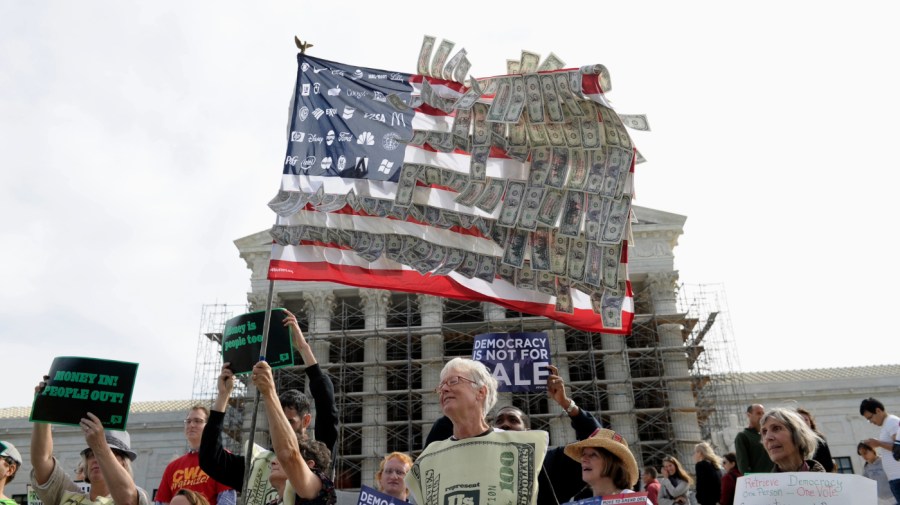
Stepping into the fall D.C. sunshine last week, a headline popped up on my phone: “The Final Money Sprint to November.”
It made me angry. I wasn’t bothered because one candidate might be raising more or less money than another candidate or because it might signal a renewed sense of energy in this election cycle.
Once a tool for funding voter engagement and communicating policy positions, raising large sums of money now seems to have become the goal in and of itself. The candidate with the deepest pockets frequently appears destined for victory, regardless of qualifications or dedication to public service. And this isn’t just a “vibes” situation — the data prove my point.
And now, in the closing days of the 2024 elections, we have learned that Vice President Kamala Harris just shattered the fundraising record for a single quarter. Does that make her more qualified to be president? Not necessarily, but the media covers the race for campaign dollars as closely as the differences between Harris’s and former President Donald Trump’s policy positions. Perhaps even more so.
Of course, the fact that money continues to pour into our political scene keeps me employed, at least in theory. I lead OpenSecrets, a nonprofit maintaining the nation’s oldest, most comprehensive dataset chronicling the financial dynamics of politics. That includes campaign donations and spending, lobbying and the murky world of “dark money,” which funnels funding from opaque sources into political operations.
Over the last two decades, the amount of money pouring into our presidential elections has ballooned from $2.6 billion in 2000 to $7.7 billion in 2020, adjusted for inflation — and nearly 90 percent of that growth happened between 2016 and 2020. OpenSecrets will do a final report when the current cycle closes, but our research team confidently projects the 2024 elections will surpass 2020 in terms of total dollars spent.
Why this massive surge in campaign dollars?
Before 2000, most presidential candidates accepted public funding, a set amount that seemed sufficient to run an election in those days.
But in the ‘90s, Ross Perot and Steve Forbes turned down public funding in favor of self-funding their campaigns, injecting a much bigger amount of capital into the system than had ever before been seen (or fathomed). This opened the portal for massive wealth — whether earned or raised — to become the new campaigning norm.
In a matter of years, we went from a presidential candidate raising in the tens of millions to more than hundreds of millions for an election.
Another important shift was the passage of the Bipartisan Campaign Reform Act. Part of an effort to curb the influence of money in politics, the act aimed to curb money’s influence by limiting “soft money” — large, unregulated donations to parties — and adjusting caps on “hard money” donations to candidates to reflect inflation. But then the Supreme Court’s Citizens United v. FEC decision dramatically reshaped the campaign finance landscape and introduced “dark money.”
The court ruling allowed corporations, unions and nonprofits to spend unlimited sums to support or attack candidates. That ruling also enabled wealthy individuals to wield much greater influence by giving to super PACs that make independent expenditures (election spending not coordinated with candidates’ campaigns).
This means that candidates who might not otherwise have the track record can suddenly become major contenders — or even winners — simply because they have the support of a wealthy backer. And none of these corporate or individual donors are required to disclose their contributions (hence the term “dark money”).
Finally, a more recent shift (and perhaps the most consequential) is the rapid evolution of technology, which has made fundraising faster, cheaper and more pervasive. Thanks to the internet, it’s easy for a candidate to get national attention and raise money from all over the country. Online fundraising platforms such as ActBlue and WinRed, both founded in the 2000s, have processed billions of dollars in the last few years alone, making politics an industry that would make a venture capitalist salivate.
It is perhaps the “X factor” of this last shift that, when combined with the others, has flooded our presidential election cycle with money at a scale our forebears and founding fathers never could have imagined.
So we find ourselves back at our question: Is money the means or the end of an election, and is public service even a factor in voters’ decisions?
If we are going to allow unlimited sums of money into our political system, we must honor transparency in the process. If we are going to say that money is a method of “free speech,” then we have to honor the fact that one of the most important aspects of free speech in a democratic republic is knowing the interlocutor. Without transparency, we risk reducing our democracy to a pay-to-play system.
Until all political donations are subject to transparency rules, I hope that some of those millionaires and billionaires might have respect for, and consider investing in, the infrastructural foundations of democracy. I’m talking about the less-than-sexy stuff that keeps our system running in 2025, again in 2027 and again in 2029 — like the people who run our elections, the news media and efforts such as ours that enable access to data on the financial influences in politics.
These institutions hold our leaders accountable and ensure they serve public interests rather than personal gain.
Without transparency and accountability, we risk the public losing trust in our system. And without trust, we will continue to retreat into polarized, partisan corners, with all the dangers that entails for our democracy.
We must act now to preserve the transparency and integrity of our democracy, elections and the future of our country.
Hilary Braseth is the executive director of OpenSecrets.














